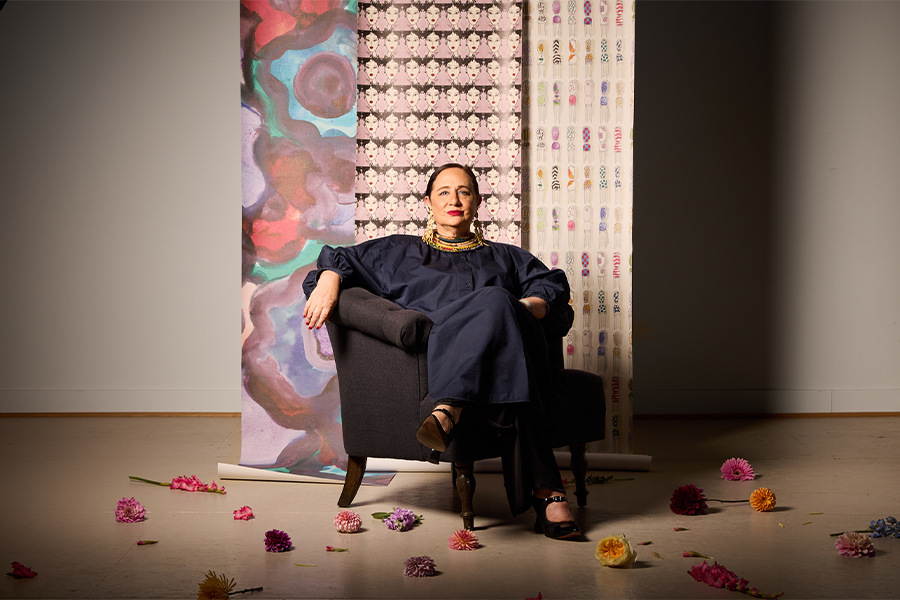From La Scala, one of the world’s most venerable opera houses, it’s about a 15-minute walk to Bisazza’s Milan flagship store in Brera, the old shop- and café-laden neighborhood that feels like “a small village,” says Rossella Bisazza, director of communications for the family-run glass mosaic maker.
It’s an especially profound route for Rossella, as it connects her two disparate professional lives. She saw her first ballet at the historic theater alongside her mother when she was 6 years old, a visual so powerful it sparked her own 12-year career as a ballet dancer. Even when she was forced to quit because of an injury, she took her passion backstage as an assistant director. La Scala, she says, is “part of my life. I would say it’s my second house.”
But when her brother Piero, Bisazza’s president and then CEO, asked her to join the business to increase its visibility, she took on the challenge and “it was love at first sight,” she recalls. “I brought the discipline I learned as a ballerina to my work.”

The spa of the Charles Hotel in Munich boasts a mosaic wall pattern that references gently waving coral branches
Bisazza was born in 1956 in Vicenza, not far from Venice. Rossella’s father Renato was a sharp entrepreneur, and he realized that manufacturing mosaics “could be interesting for the industry,” says Rossella. In the 1960s, buildings and interiors were being renovated after the war, and Bisazza stepped in. It kicked off with Vetricolor, a square of colored glass. Soon, its weatherproof mosaics were covering structures across Italy and France.
Renato also knew that collaborating with designers was key to Bisazza’s expansion, and between 1995 and 1999, the late Alessandro Mendini served as art director, weaving Bisazza products into such high-profile architectural projects as the Louisiana Museum of Modern Art in Denmark. Since then, Bisazza has teamed up with the likes of Tom Dixon, Jaime Hayon, India Mahdavi, David Rockwell, and Patricia Urquiola. “Alessandro opened up the doors of the design world to our company,” Rossella points out.
Reaching out to potential artists and designers for Bisazza partnerships also falls under Rossella’s purview, although at first, she admits, she was a bit shy contacting A-list talents, anticipating they wouldn’t say yes. She was delightfully wrong.

Found at the Bisazza Foundation, the Love Over All installation by Fabio Novembre depicts two bodies searching for each other in tile
During the 2024 edition of Salone del Mobile, for example, New York artist and Snarkitecture founder Daniel Arsham unveiled two striking works composed of Bisazza glass mosaics that merged Roman sculptures with manga caricatures. This unlikely fusion marked a contemporary, pop-culture turning point for Bisazza, a path to reach younger consumers the company will continue to explore. “We have a culture and past, but also we want to look at the future,” Rossella explains. “These artists have visions that we sometimes don’t have. They show off how to use mosaic in an outstanding way.”
Beyond Bisazza’s tile collections, the place to see this creativity magnified is the private nonprofit cultural institution in Montecchio Maggiore that Bisazza founded in 2012, the same year Renato passed away. At the Bisazza Foundation, temporary exhibitions and a permanent trove of large-scale works that Rossella likens to something out of Alice in Wonderland, include the small, stone-swathed Antelope car from Amsterdam designer Marcel Wanders and Milanese designer Fabio Novembre’s sweeping Love Over All installation.
All the talents commissioned by Bisazza are given complete freedom. Especially at the foundation, they can showcase the mosaics however they see fit. “It can be minimalistic, opulent, or architectural. We are always surprised by the fantasy, by the incredible variety of outcomes,” says Rossella. “Visitors understand mosaics can do more than just clad your bathroom.”

The pastel Ortensia tiles play a starring role in the pool at L’Albereta Relais & Chateaux in Italy

Custom Bisazza mosaics in delicate green hues clad a villa closet at Joali Being in the Maldives
This article originally appeared in HD’s November 2024 issue.


